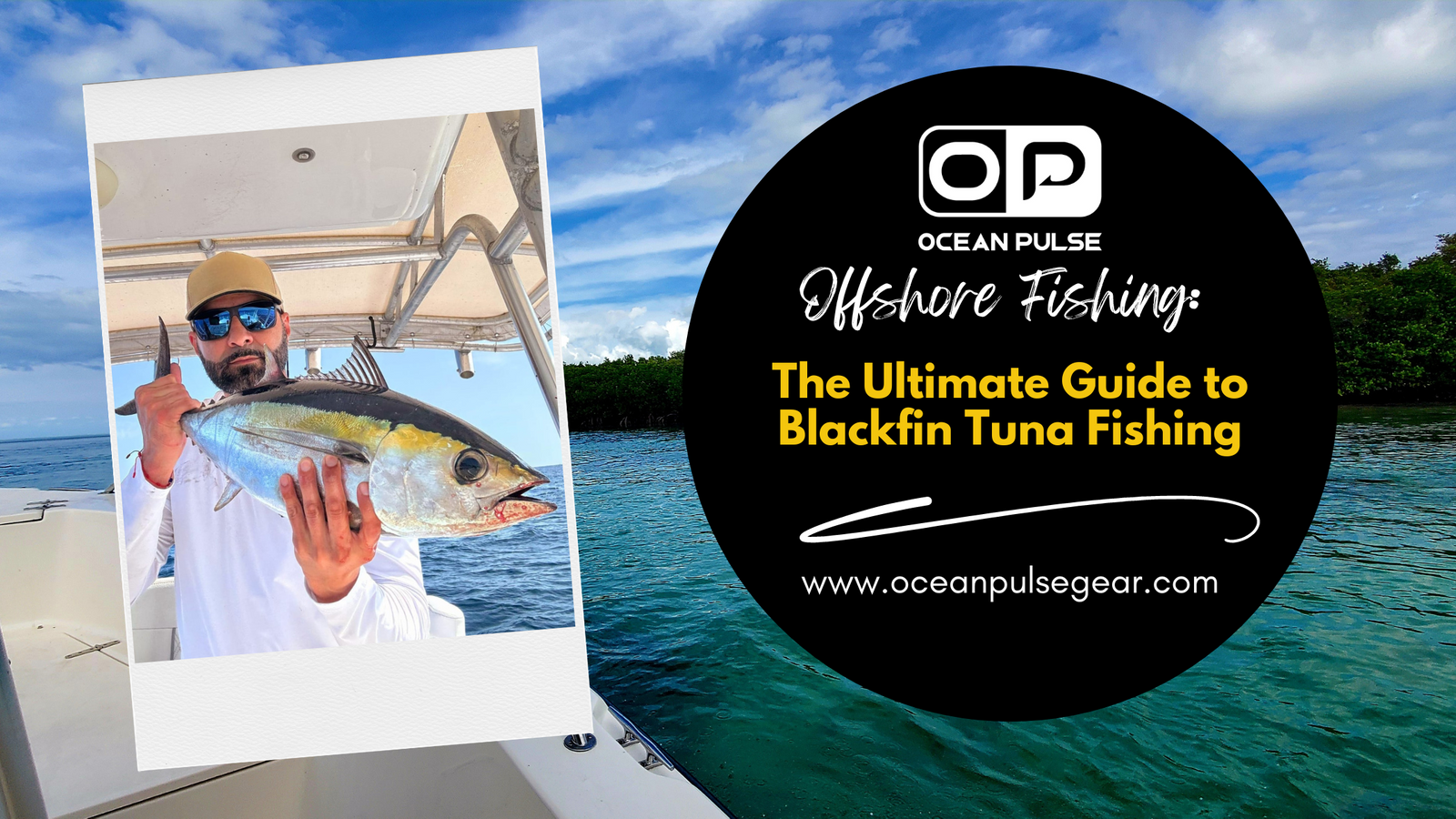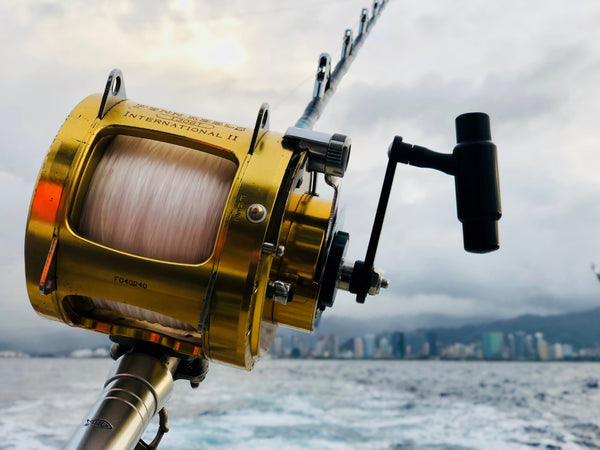Welcome to Ocean Pulse Gear, Please Enjoy Free Shipping on all orders!
Welcome to Ocean Pulse Gear, Please Enjoy Free Shipping on all orders!
The Ultimate Guide to Blackfin Tuna Fishing
October 15, 2025 5 min read

The Ultimate Guide to Blackfin Tuna Fishing
Introduction to Blackfin Tuna
Blackfin Tuna are one of the most exciting pelagic fish you can target. Their speed, power, and willingness to hit a variety of baits make them a favorite among offshore anglers. They may be the smallest of the tuna species, but what they lack in size they more than make up for in fight and flavor. Found throughout the warm waters of the Atlantic Ocean, Gulf of America, and Caribbean, these fish put even experienced anglers to the test.

@Marine_man_mike with a nice Blackfin Tuna on the Troll.
- Species: Thunnus atlanticus
- Description: Blackfin Tuna have a sleek, torpedo-shaped body with dark blue to black coloring on the back, silver sides, and a bright white belly. They feature distinctive yellow finlets and a metallic sheen when viewed in sunlight.
- Size Range: 15–30 inches (average), up to 40 inches (maximum)
- Weight Range: 10–30 pounds (average), up to 50 pounds (maximum)
Life Span: Up to 5 years
Habitat and Behavior
Blackfin Tuna are fast-moving, schooling fish that thrive in warm tropical and subtropical waters. While often considered an offshore species, they are known to venture closer to shore when bait is abundant.
-
Typical Habitat: Open ocean, nearshore waters, along current edges, temperature breaks, and near floating debris or sargassum.
-
Depth Range: Surface to 600 feet, often caught in the upper 200 feet.
-
Feeding Style: Opportunistic carnivores feeding on small fish, squid, flying fish, and crustaceans. They hunt in large schools, often with skipjack tuna or mahi-mahi, and are known for blitz-style surface feeding.
-
Seasonal Patterns: Active year-round with the best action during spring and fall migrations. In the Florida Keys and Gulf of Mexico, they are often found around offshore humps and seamounts where bait concentrates.
Gear and Tackle Recommendations
Blackfin Tuna are small compared to yellowfin or bluefin but are extremely strong for their size. Using appropriately sized tackle helps ensure a sporting fight while minimizing fatigue.
-
Recommended Tackle: Medium to heavy spinning or trolling setups rated for 30–50 lb line.
-
Line Type and Strength: 30–50 lb braided line for strength and capacity, with a short monofilament topshot for stretch and shock absorption.
-
Leader Recommendations: 30–50 lb fluorocarbon leader to reduce visibility in clear water and resist abrasion.
-
Hook Size: 4/0 to 6/0 circle or live bait hooks.
-
Weights: 1–3 ounce egg sinkers or trolling leads, adjusted for depth and current.
-
Pro Tip: Keep a light spinning outfit rigged with a small jig or topwater plug for sudden surface feeds. Blackfin often blitz unexpectedly.
Bait Selection
Selecting the right bait and presentation can make all the difference when targeting Blackfin Tuna.
-
Preferred Live Baits: Pilchards, sardines, small mackerel, cigar minnows, and blue runners.
-
Cut and Dead Baits: Bonito strips, squid, or ballyhoo chunks.
-
Artificial Lures: Small metal jigs, poppers, topwater plugs, cedar plugs, feather jigs, and skirted lures. Tuna feathers and small jet heads trolled at 5–8 knots are classic producers.
-
Presentation Tips: Match the hatch by using bait or lures that mimic local forage. Keep live bait lively and free-lined naturally into feeding schools.
-
Importance of Freshness: Fresh bait produces more scent, natural action, and consistent strikes. Always discard washed-out chunks and replace with new ones.
Fishing Rigs
Having the right rig makes a big difference, especially when adapting to conditions or switching from trolling to chunking.
-
Fish-Finder Rig: Sliding sinker on the mainline, tied to a swivel, followed by 3–4 feet of 30–50 lb fluorocarbon leader and a circle hook. Great for drifting baits through the water column.
-
Knocker Rig: Egg sinker slides directly above the hook, ideal for fishing close to the bottom or targeting fish deep in the chum slick.
-
Sliding Sinker Rig: Sinker slides on the mainline with a short mono leader attached to a swivel, then 3–4 feet of 30 lb fluorocarbon leader with a circle hook.
-
Chunking Rig: 6/0 circle hook on a 4-foot fluorocarbon leader tied to a small swivel. Used for drifting chunk baits in a chum line.
Effective Fishing Techniques
Trolling
Trolling is a go-to technique for covering water and locating feeding schools.
Step-by-Step Instructions:
-
Select a Productive Area: Focus on current edges, weed lines, temperature breaks, and floating debris.
-
Rig Setup: Use 30–50 lb tackle with small to medium lures or rigged ballyhoo.
-
Lures and Baits: Cedar plugs, small skirted lures, tuna feathers, or jet heads.
-
Trolling Speed: 5–8 knots is ideal to match the speed of fleeing baitfish.
-
Depth Control: Use planers or downriggers to vary the presentation.
-
Watch for Signs: Birds diving and surface splashes are strong indicators of feeding fish.
-
Hook and Fight: When a rod goes off, keep the boat moving forward briefly to avoid tangles, then fight the fish steadily with consistent pressure.
Chunking
Chunking is a classic technique for targeting Blackfin when they are holding deep or schooling near structure.
Step-by-Step Instructions:
-
Find Structure: Fish near humps, seamounts, or deep ledges where baitfish concentrate.
-
Create a Chum Slick: Toss small chunks of bait overboard at regular intervals.
-
Rig and Bait: Free-line a chunk or live bait on a fluorocarbon leader into the slick.
-
Drift Presentation: Keep baits at varying depths to locate feeding fish.
-
Timing the Hookset: Let the tuna fully take the bait before setting the hook.
-
Tip: Keep the chum consistent but moderate. Over-chumming can fill fish too quickly.
Casting
When Blackfin Tuna are busting on the surface, casting can be both thrilling and productive.
Step-by-Step Instructions:
-
Locate the Action: Look for birds diving and bait spraying from surface feeds.
-
Gear Setup: Use medium spinning gear with 20–40 lb braid.
-
Choose the Lure: Small metal jigs, topwater poppers, or stickbaits.
-
Approach Quietly: Ease into range and cast beyond the feeding school.
-
Retrieve: Fast, steady retrieves mimic fleeing baitfish.
-
Hook and Fight: Maintain consistent pressure and avoid high drag to prevent pulled hooks.
Tips for Consistent Success
-
Stay Mobile: Tuna move fast. Be prepared to relocate if the bite slows.
-
Look for Life: Birds, flying fish, and temperature changes often reveal tuna activity.
-
Bait Management: Keep bait fresh and replace dead ones often.
-
Tackle Check: Inspect leaders frequently for frays and replace after each fish.
-
Light Line Advantage: Downsizing leaders and line strength can dramatically increase strikes in clear water.
Best Time of Year to Catch
-
Peak Seasons: Spring and fall are prime, particularly during migration along the Gulf Stream and Florida Keys.
-
Regional Highlights:
-
Florida Keys: Excellent year-round, especially around humps like the Islamorada Hump.
-
Gulf of America: Productive spring through early winter near rigs, offshore platforms and shrimp boats.
-
Bahamas and Caribbean: Best from February through May when bait is abundant.
-
Conservation and Regulations
-
Size and Bag Limits: Regulations vary by state and region, so always check local rules before fishing.
-
Sustainable Fishing Practices:
-
Use circle hooks to minimize injury.
-
Limit your harvest and release smaller fish.
-
Handle tuna gently, keeping them in the water as much as possible during release.
-
Local Knowledge and Expert Advice
-
Insights: Early morning and late afternoon bites tend to be best. Tuna often rise higher in the water column during low light.
-
Expert Tip: Always keep one bait deeper than the rest when trolling or chunking. The biggest Blackfin often sit below the main school.
-
Common Challenges: Avoid losing fish to sharks by reeling quickly and staying alert.
Conclusion
Blackfin Tuna offer one of the most exciting offshore experiences for anglers of all skill levels. Their combination of speed, power, and abundance makes them a perfect target for those looking to test their gear and skill. Whether trolling offshore humps, chunking over deep ledges, or casting into surface feeds, mastering these techniques will give you consistent success. Respect the resource, handle your catch carefully, and enjoy the thrill of one of the ocean’s most spirited fighters.
Leave a comment
Comments will be approved before showing up.

Become an OP VIP, sign up for exclusive discounts offers and event coverage.
Sign up below!
